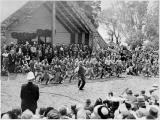The Labour government created the Tribunal to hear Māori claims of breaches of the Treaty of Waitangi. It has evolved ever since, adapting to the demands of claimants, government and public.
Treaty Of Waitangi
Events In History
Chief Justice Sir James Prendergast’s statements when delivering judgment in the case of Wi Parata v The Bishop of Wellington would influence decision-making on Treaty of Waitangi issues for decades.
The Native Land Court was one of the key products of the Native Lands Act 1865. It enabled the conversion of traditional communal landholdings into individual titles, making it much easier for Pākehā to purchase Māori land.
After hundreds of Ngāpuhi fighters led by Kawiti and Hōne Heke attacked Kororāreka (Russell), most of its inhabitants were evacuated by sea. The flagstaff on nearby Maiki Hill was cut down for the fourth and last time.
The first Māori to sign the Treaty of Waitangi, Ngāpuhi chief Hōne Heke Pōkai soon became disenchanted with the consequences of colonisation.
Lieutenant-Governor William Hobson proclaimed British sovereignty over all of New Zealand – the North Island on the basis of cession through the Treaty of Waitangi, and South and Stewart Islands by right of discovery.
More than 40 Māori chiefs signed a treaty with the British Crown in the Bay of Islands. The Treaty of Waitangi remains controversial.
Thirty-four northern chiefs signed He Whakaputanga (a declaration of independence) at a hui called by the British Resident, James Busby.
Articles
The 1940 Centennial
The centennial celebrations of 1940 marked a century of European effort and progress. Māori history and the centenary of the signing of the Treaty of Waitangi took a back seat. Read the full article
Page 5 - The Treaty of Waitangi
Despite all the talk of the 'birth of a nation', the place of the Treaty of Waitangi or Māori in the centennial celebrations was less
Waitangi Day
Every year on 6 February, New Zealand marks the signing of the Treaty of Waitangi in 1840. For most people, Waitangi Day is a holiday; for many, and especially for Māori, it is a time for reflecting on the Treaty and its place in modern New Zealand. Read the full article
Page 1 - Waitangi Day
Every year on 6 February, New Zealand marks the signing of the Treaty of Waitangi in 1840. For most people, Waitangi Day is a holiday; for many, and especially for Māori, it is a
Page 3 - Waitangi Day 1940s-1950s
From the 1940s the Treaty and Waitangi began to find a place in the national consciousness. For most New Zealanders, they were of historical interest
Links - Treaty of Waitangi
Links and further information about the Treaty of Waitangi Read the full article
Page 1 - Treaty of Waitangi links
Links and further information about the Treaty of
History of the Governor-General

New Zealand has had a governor or (from 1917) a governor-general since 1840. The work of these men and women has reflected the constitutional and political history of New Zealand in many ways. Read the full article
Page 3 - Crown colony era
New Zealand became a British colony in 1840, legitimised by the Treaty of Waitangi and Lieutenant-Governor William Hobson's 21 May declaration of
Māori King movement origins

In May 2008 Māori gathered at Ngāruawāhia to celebrate the 150th anniversary of the formation of the Kīngitanga, or Māori King Movement. The current king, Te Arikinui Tūheitia Paki, was crowned in August 2006 following the death of his mother, Dame Te Atairangikaahu. Read the full article
Page 3 - The land issue
Pressure to sell land was a key factor in the creation of the Kīngitanga. Before European settlement Māori had no concept of selling land and few chiefs had the authority to gift
Māori King movement - 1860-94

King Tāwhiao's reign was dominated by the Waikato War and the fallout from it. Read the full article
Page 4 - Raupatu
Under the terms of the New Zealand Settlements Act 1863 the government confiscated huge areas of Māori land in late
Read the Treaty

Transcript of the English version of the original Treaty of Waitangi document. Read the full article
Page 1 - Read the Treaty
Transcript of the English version of the original Treaty of Waitangi
Page 2 - Māori text of Te Tiriti
Transcript of the Māori version of the original Treaty of Waitangi
Page 3 - Differences between the texts
The Treaty of Waitangi has two texts. The Maori version is not an exact translation of the English, and there are important differences.
Page 5 - Further information
Further information on the wording of the Treaty of
Treaty signatories and signing locations
The Treaty of Waitangi was signed on nine separate sheets by more than 500 Māori. Find out more about the sheets, the signatories and the signing locations Read the full article
Page 1 - Treaty sheets and signing locations
The Treaty of Waitangi was signed on nine separate sheets by more than 500 Māori. Find out more about the sheets, the signatories and the signing
Page 2 - Ngā tohu – treaty signatories
When complete, Ngā tohu – treaty signatories will include biographical information on every signatory of the Treaty of Waitangi who can be
Page 4 - Making the Treaty of Waitangi
New Zealand's founding document, the Treaty of Waitangi, was prepared over just a few days in February 1840. Several versions of the treaty were taken around the country for
Page 5 - Signing the treaty
By the end of 1840 about 540 Māori, including 13 women, had signed the Treaty of Waitangi; all but 39 signed the Māori text. While some had clear expectations about what their
Page 6 - Preserving the documents
The Treaty of Waitangi is currently on display in the He Tohu exhibition at the National Library of New Zealand in Wellington. It has not always been so secure. Water, time and
Page 7 - Further information
Further information on the signing of the Treaty of
The Treaty in practice
Amalgamating Māori into colonial settler society was a key part of British policy in New Zealand after 1840. Economic and social change, along with land-purchase programmes, were central to this process. Read the full article
Page 1 - The Treaty in practice
Amalgamating Māori into colonial settler society was a key part of British policy in New Zealand after 1840. Economic and social change, along with land-purchase programmes, were
Page 2 - Slide to war
War raged in the North Island in the mid-19th century. The period from 1860, when conflict broke out in Taranaki, through to about 1872, is commonly called the New Zealand Wars.
Page 3 - Obtaining land
How to obtain land for European settlement was always a key issue in New Zealand. With the wars of the 1860s, a new legal system backed up conquest as a means of gaining Māori
Page 4 - Shared issues and approaches
Prospects for Māori looked bleak at the beginning of the 20th century. A shared sense of grievance emerged, and new leaders paved the way for new approaches to the
Page 5 - Growing interest in the Treaty
The early 20th century saw new approaches to dealing with Māori grievances and a renewed interest in the Treaty of Waitangi as the nation's founding
Page 6 - The Treaty debated
Modern New Zealand has debated the Treaty of Waitangi as never before. Understanding, reconciliation, protest and confrontation have been part of this
Page 7 - The Ngāi Tahu claim
Ngāi Tahu signed a Deed of Settlement with the Crown in 1998. This completed almost 150 years of the tribe's struggle to have the Crown honour its obligations under the Treaty of
Page 9 - Further information
A selection of further information on the Treaty in practice.
Taming the frontier

In 1832 James Busby was appointed as the official British Resident to New Zealand. After arriving in the Bay of Islands in May 1833 he took steps to tame what he saw as a chaotic frontier society. Read the full article
Page 4 - Land issues on the eve of the Treaty of Waitangi
In the late 1830s the British government became concerned about how land was being obtained from Māori. Action was needed, it decided, to protect Māori from the worst ravages of
Page 5 - A separate Crown colony
Protecting Māori, regulating land purchases, controlling the activities of settlers and dealing with the potential influx of migrants underpinned British policy in 1839. New
Treaty timeline

See some of the key events between 1800 and 1849 relating to the Treaty of Waitangi. Read the full article
Page 1 - Treaty events 1800-49
See some of the key events between 1800 and 1849 relating to the Treaty of Waitangi.
Page 2 - Treaty events 1850-99
See the key events between 1850 and 1899 relating to the Treaty of
Page 3 - Treaty events 1900-49
Discover some of the key events between 1900 and 1949 relating to the Treaty of
Page 4 - Treaty events since 1950
Learn about some of the key events from 1950 onwards relating to the Treaty of
Page 5 - Further information
Find out more about the
Treaty biographies
Information about some of the key people who have featured in the story of the Treaty of Waitangi Read the full article
Page 1 - Treaty biographies
Information about some of the key people who have featured in the story of the Treaty of
Page 2 - Further information
Discover more Treaty
The Treaty in brief
The Treaty of Waitangi is New Zealand’s founding document. It takes its name from the place in the Bay of Islands where it was first signed, on 6 February 1840. The Treaty is an agreement, in Māori and English, that was made between the British Crown and about 540 Māori rangatira (chiefs). Read the full article
Page 1 - The Treaty in brief
The Treaty of Waitangi is New Zealand’s founding document. It takes its name from the place in the Bay of Islands where it was first signed, on 6 February 1840. The Treaty is an
Page 2 - Treaty FAQs
Answers to some common questions about the Treaty of
Page 3 - Further information
More information, in brief, on the Treaty of
Treaty of Waitangi

Activities to determine what students already know about the Treaty of Waitangi Read the full article
Page 1 - Treaty of Waitangi
Activities to determine what students already know about the Treaty of Waitangi
Political and constitutional timeline

Pivotal political and constitutional events with links to further information Read the full article
Page 1 - Political and constitutional timeline
Pivotal political and constitutional events with links to further
A history of New Zealand 1769-1914
In the period between the first European landings and the First World War, Aotearoa New Zealand was transformed from an exclusively Māori world into one in which Pākehā dominated numerically, politically, socially and economically. Read the full article
Page 1 - History of New Zealand, 1769-1914
In the period between the first European landings and the First World War, Aotearoa New Zealand was transformed from an exclusively Māori world into one in which Pākehā dominated
Teaching te Tiriti o Waitangi

Te Tiriti/the Treaty has been variously described as a founding document, a sacred covenant and a fraud. It speaks through many voices, past and present. So, what are some ways to teach the history of this document and analyse its ongoing impacts? Read the full article
Page 1 - Teaching Te Tiriti o Waitangi
Te Tiriti/the Treaty has been variously described as a founding document, a sacred covenant and a fraud. It speaks through many voices, past and present. So, what are some ways to
Stories in the land field trip
Page 2 - Stories in the land field trip
Field trips are a fantastic way for students and teachers to develop shared experiences outside of the classroom. This field trip – ‘Stories in the land’ – is facilitated by
































































